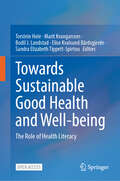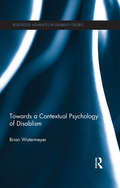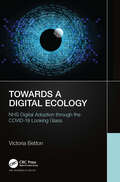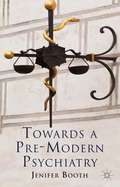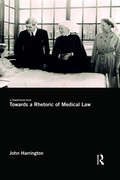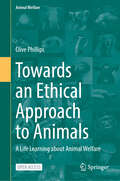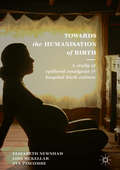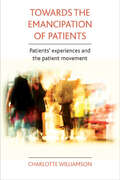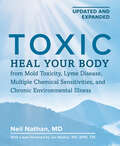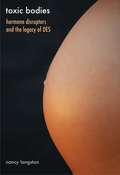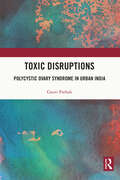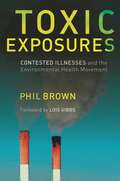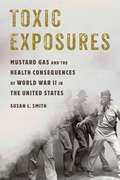- Table View
- List View
Towards Sustainable Good Health and Well-being: The Role of Health Literacy
by Torstein Hole Marit Kvangarsnes Bodil J. Landstad Elise Kvalsund Bårdsgjerde Sandra Elizabeth Tippett-SpirtouThe purpose of this open access book is threefold. The first is to shed light on patient participation and health literacy for Good Health and Well-being, which is one of the UN's Sustainable Development Goals. Health literacy is considered a prerequisite for patients to be able to participate in shared decisions on their own treatment (WHO,1998). Health literacy has received increased international attention: the concept is linked to person-centred health services, sustainable resource utilization, health-promoting and preventive health work, treatment of chronic diseases and social inequality (WHO, 2016). The second purpose is to provide health professionals and students with educational models for building health literacy for patients and relatives. This purpose is linked to Quality Education, one of the UN's sustainability goals. The third purpose is to present critical perspectives on the demand for sustainability in healthcare services. Both ethical dilemmas and philosophical reflections on patient participation, health literacy and sustainability are presented. The Norwegian definition of health literacy is as follows: “Health competence is a person's ability to understand, assess and apply health information to be able to take knowledge-based decisions related to one's own health. This applies to both decisions related to lifestyle choices, disease prevention measures, self-management of disease and use of the health and care service” (Helsedireektoratet, 2020). The sustainability goal is clearly outlined in this definition, although the organisational perspective on health literacy is lacking. Patient participation leads to improved patient satisfaction and safety (Castro, Van Regenmortel, Vanhaecht, Sermeus, & Van Hecke, 2016; Collins, Britten, Ruusuvuori, & Thompson, 2007; Vahdat, Hamzehgardeshi, Hessam, & Hamzehgardeshi, 2014), efficient co-operation between patients and healthcare professionals, and enhanced management ofthe disease (Collins et al., 2007; Vahdat et al., 2014). Health literacy as well as patient participation are important aspects for sustainable development and good and effective healthcare services in the future.
Towards Ultrasound-guided Spinal Fusion Surgery
by Amir ManbachiThis thesis describesthe design and fabrication of ultrasound probes for pedicle screw guidance. Theauthor details the fabrication of a 2MHz radial array for a pedicle screw insertioneliminatingthe need for manual rotation of the transducer. He includes radial images obtainedfrom successive groupings of array elements in various fluids. He also examines the manner in which it canaffect ultrasound propagation.
Towards Universal Health Care in Emerging Economies
by Ilcheong YiThis book explores how political, social, economic and institutional factors in eight emerging economies have combined to generate diverse outcomes in their move towards universal health care. Structured in three parts, the book begins by framing social policy as an integral system in its own right. The following two parts go on to discuss the opportunities and challenges of achieving universal health care in Thailand, Brazil and China, and survey the obstacles facing India, Indonesia, Russia, South Africa and Venezuela in the reform of their health care systems. The evolution of social policy systems and the cases in this volume together demonstrate that universalism in health care is continuously redefined by the interactions between diverse political forces and through specific policy processes. At a time when international and national-level discourse around health systems has once again brought universalism to the fore, this edited collection offers a timely contribution to the field in its thorough analysis of health care reform in emerging economies.
Towards a Contextual Psychology of Disablism (Routledge Advances in Disability Studies)
by Brian WatermeyerIn recent years, disability studies has been driven by a model of disability which focuses on the social and economic oppression of disabled people. Although an important counterbalance to a pathologising medical model, the social model risks presenting an impoverished and disembodied view of disability, one that ignores the psychological nature of oppression and its effects. This innovative work argues that a psychological framework of disability is an essential part of developing a more cohesive disability movement. Brian Watermeyer introduces a new, integrative approach, using psychoanalysis to tackle the problem of conceptualising psychological aspects of life with disablism. Psychoanalytic ideas are applied to social responses to impairment, making sense of discrimination in its many forms, as well as problems in disability politics and research. The perspective explores individual psychological experience, whilst retaining a rigorous critique of social forces of oppression. The argument shows how it is possible to theorise the psychological processes and impressions of discriminatory society without pathologising disadvantaged individuals. Drawing on sociology, social anthropology, psychology and psychoanalysis - as well as clinical material - Towards a Contextual Psychology of Disablism shapes a view of disabled subjectivity which is embodied, internal, and political. Presenting a range of conceptual ideas which describe psychological dynamics and predicaments confronting disabled people in an exclusionary and prejudiced world, this volume is an important new contribution to the literature. It will interest students and researchers of disability studies, including those working within psychology, education, health and social work.
Towards a Digital Ecology: NHS Digital Adoption through the COVID-19 Looking Glass
by Victoria BettonTowards a Digital Health Ecology at the NHS: Healthcare Technology Adoption through the COVID-19 Looking Glass is about technology adoption in the U.K.’s National Health Service (NHS) as told from the inflection point of a disaster. In 2020 the world lived through a disaster of epic proportions, devastating humanity around the globe. It took a microscopic virus to wreak havoc on our healthcare system and force the adoption of technology in a way that had never been seen before. This book tells the story of digital technology take-up in the NHS through the lens of that disaster. The COVID-19 pandemic is the most significant global health crisis to occur since the advent of digital technologies, ubiquitous data, and widespread use of mobile technologies. This book documents use of technology in the NHS through the lens of the first pandemic shock. This healthcare system, paid for by general taxation and free at the point of demand, was conceived and developed in a firmly analogue world. Created in 1948, the NHS predates the invention of the World Wide Web by some forty years. This is not a book simply about technology, it is a study of the painful process of reengineering a mammoth and byzantine system that was built for a different era. This book is about more than technology. The digital health sector is a microcosm of the wider healthcare system, through which grand themes of social inequality, public trust, private versus commercial interests, values and beliefs are played out. The sector is a clash of competing discourses: the civic and doing good for society; the market and wealth creation; the industrial creating more efficient and effective systems; the project expressed as innovation and experimentation; lastly the notion of vitality and leading a happier, healthy life. Each of these discourses exists in a state of flux and tension with the other. Oscillating between them, this book is offered as a critique of the role of digital technologies within healthcare. It is an examination of competing interests, approaches, and ideologies. It is a story of system complexity told through analysis and personal stories.
Towards a Pre-Modern Psychiatry
by Jenifer BoothResponding to the work of previous critics of psychiatry, who have associated its undue dominance with both a modern scientific paradigm and political factors, Jenifer Booth puts forward a theoretical challenge based on MacIntyres work on Aquinas and Aristotle, but adding the museum and assembly as conceptual thinking tools. MacIntyres work on practices, tradition-constituted enquiry, Marxist ideology and Kuhn are all used in putting forward a pre-modern view of knowledge. The feminist philosophy of Luce Irigaray widens the project to include psychotherapy. Booth puts forward a workable and kind version of psychiatric medicine which sets the work of the mental health service user movement in context. This book should be of value to anyone who has ever wondered why doctors have so much power or who has thought that spiritual and social factors should have more weight in medicine. It will be of interest to moral philosophers, theologians and feminist theologians, philosophers of medicine and museums studies professionals alike.
Towards a Professional Model of Surrogate Motherhood
by Ruth Walker Liezl Van ZylThis book delves deeply into modern surrogacy arrangements, responding to both practical and ethical critiques by offering a radically new model for surrogate motherhood. Current practice distinguishes between two models of surrogacy - the altruistic (unpaid) model and the commercial (paid) model, both of which present social, ethical, and conceptual challenges. This book proposes a novel arrangement for surrogate motherhood - the professional model. Inspired by professions, such as nursing, teaching, and social work, the professional model acknowledges the caring motives that surrogate mothers have while at the same time compensating them for their work. Walker and Van Zyl adopt an evidence-based approach to explain that the professional model enables trust between intended parents and surrogates, provides professional support at every stage of the relationship, affords legal protections against exploitation and commodification, and recognizes the rights and interests of all parties, including the intended baby. The model applies to both transnational and domestic surrogacy and will be of great interest to policy makers, social researchers, bioethicists, legal scholars, fertility professionals, clinicians, and graduate students in psychology, philosophy, medicine and ethics.
Towards a Rhetoric of Medical Law: Against Ethics
by John HarringtonChallenging the dominant account of medical law as normatively and conceptually subordinate to medical or bioethics, this book provides an innovative account of medical law as a rhetorical practice. The aspiration to provide a firm grounding for medical law in ethical principle has not yet been realized. Rather, legal doctrine is marked, if anything, by increasingly evident contradiction and indeterminacy that are symptomatic of the inherently contingent nature of legal argumentation. Against the idea of a timeless, placeless ethics as the master discipline for medical law, this book demonstrates how judicial and academic reasoning seek to manage this contingency, through the deployment of rhetorical strategies, persuasive to concrete audiences within specific historical, cultural and political contexts. Informed by social and legal theory, cultural history and literary criticism, John Harrington’s careful reading of key judicial decisions, legislative proposals and academic interventions offers an original, and significant, understanding of medical law.
Towards a Sociology of Cancer Caregiving: Time to Feel
by Rebecca E. OlsonOnce a synonym for death, cancer is now a prognosis of multiple probabilities and produces a world of uncertainty for carers. Drawing on rich, in-depth interview data and employing interactionist theories, Towards a Sociology of Cancer Caregiving explores carers' lived experiences, paying close attention to the ways in which spouse carers manage the ambiguity that pervades their orientations to the future, their responsibilities and their emotions. A detailed exploration of the temporal and emotional journeys of spouse carers of cancer patients, this volume raises and responds to new questions about how to conceptualise informal caregiving, offering a fresh theorisation of the uncertainty that now characterises cancer. As such, it will appeal to scholars of the sociologies of emotion, time and identity, and all those interested in the question of how to support informal carers.
Towards a Sociology of Nursing
by Ricardo A. AyalaTowards a Sociology of Nursing offers fresh insights from recent research into the nursing profession. Nurses represent an important part of the professionally trained female workforce and, being a middle-class profession, changes in nursing reflect changes of many working women worldwide. Scholarship addressing these changes, however, often consists of narratives of nurses talking about themselves, which can be enriched by a sociological background that foregrounds hypotheses.In this book, Ricardo A. Ayala problematises the realities which inform, affect and shape nursing, offering new perspectives on the consequences of those social realities for the nursing profession and society more broadly. He draws on extensive field research with nurses in the workplace, spending time with them, interviewing key actors and reading and analysing documents critically through a distinctive sociological lens.
Towards a Theoretical Neuroscience: from Cell Chemistry to Cognition
by L. Andrew CowardThe book explains how to understand cognition in terms of brain anatomy, physiology and chemistry, using an approach adapted from techniques for understanding complex electronic systems. These techniques create hierarchies of information process based descriptions on different levels of detail, where higher levels contain less information and can therefore describe complete cognitive phenomena, but are more approximate. The nature of the approximations are well understood, and more approximate higher level descriptions can therefore be mapped to more precise detailed descriptions of any part of a phenomenon as required. Cognitive phenomena, the anatomy and connectivity of major brain structures, neuron physiology, and cellular chemistry are reviewed. Various cognitive tasks are described in terms of information processes performed by different major anatomical structures. These higher level descriptions are selectively mapped to more detailed physiological and chemical levels.
Towards a Theory of Thinking
by Albrecht Von Müller Britt Glatzeder Vinod GoelThinking is one of the most fascinating and characteristic abilities of human beings. To advance our understanding of this distinctive feature that makes us human is not only an exciting scientific challenge but also of great relevance in terms of coping with more and more complex challenges of the world we live in and in terms of becoming the core value creation process in an increasingly knowledge-based economy. The present book is the second volume of the Parmenides book series "On Thinking" dedicated to explore current approaches and contributions towards a fuller understanding of human thought processes. It focuses on assembling building blocks for a conceptual framework that might - after several iterations - contribute to a future theory of thinking. It brings together an international group of leading scientists coming from the different fields upon which a theory of thinking must build: brain and cognitive sciences, experimental and developmental psychology, evolutionary anthropology and biology, linguistics, transcultural neuroimaging, modeling and philosophy.
Towards an Ethical Approach to Animals: A Life Learning about Animal Welfare (Animal Welfare #26)
by Clive PhillipsIn two parts, this open access work offers a broad and often unconventional approach to animal ethics, written by a pioneer in animal welfare science and ethics. The author Clive Phillips, Australia's first professor of animal welfare, first describes his life experience and career in the field, which enabled him to provide thoughts and possible solutions to some of the key problems in human-animal relations following in section two. His memoirs describe a journey from privileged upbringing in the Christian tradition to confronting Australian livestock industries with some of their traditional practices. Experiences meeting livestock farmers, industry supporters and national representative bodies taught him new approaches to the ways in which we manage animals. After building one of the largest animal welfare centers worldwide, Clive Phillips retired and pursues his animal welfare mission independently. The second part introduces novel aspects that evolved with the author over several decades of involvement in animal welfare science. This part takes a wide perspective, asking how important and unique our animal kingdom is, how did it evolve and why, and what are the key issues for our treatment of other animals? It concludes by considering our future relationship with animals and how this will change with current developments in society and in particular contemporary attitudes toward the consumption of animals. This historical and futuristic look at animal ethics is unique, making this book a thought provoking read for all interested. The audience includes, but is not limited to, the areas of veterinary science, ethics and welfare, animal industries, universities and philosophy departments.
Towards the Future of Surgery (New Paradigms in Healthcare)
by Jacopo Martellucci Francesca Dal MasThe book provides an overview of the characteristics and skills – both technical and soft - needed to become the surgical leaders of tomorrow. During the COVID pandemic, the methodological weakness in accessing and disseminating information in has become evident: this has fostered the digital development and has favoured the creation of networks and communities of individuals (not only physicians or surgeons) pointing the way to global knowledge sharing. The development of the technological offer applied to surgery has been very rapid, with the integration of minimally invasive and robotic surgery with artificial intelligence and computerization of decision-making processes, up to the extreme limit of space surgery. However, in the future of this discipline surgeons will no longer need to consider only improved access to knowledge and evolution of technology, as a great challenge will be represented by the parallel development of non-technical skills (leadership, communication, team-working) and by the careful application of healthcare management principles to clinical practice. Finally, in the near future (but already in the present), it will be impossible to ignore the economic impact of high-tech care and equity in access to care. The book describes a journey, which starts from the history of surgical education to cross the most relevant perspectives of present and future, exploring new learning models, the thousand applications of artificial intelligence, and surgical technology to the space and back.
Towards the Humanisation of Birth: A study of epidural analgesia and hospital birth culture
by Elizabeth Newnham Lois McKellar Jan PincombeThis book examines the future of birthing practices, particularly by focusing on epidural analgesia in childbirth. It describes historical and cultural trajectories that have shaped the way in which birth is understood in Western, developed nations. In setting out the nature of epidural history, knowledge and practice, the book delves into related birth practices within the hospital setting. By critically examining these practices, which are embedded in a scientific discourse that rationalises and relies upon technology use, the authors argue that epidural analgesia has been positioned as a safe technology in contemporary maternity culture, despite it carrying particular risks. In examining alternative research the book proposes that increasing epidural rates are not only due to greater pain relief requirements or access but are influenced by technocratic values and a fragmented maternity system. The authors outline the way in which this epidural discourse influences how information is presented to women and how this affects their choices around the use of pain relief in labour.
Towards the emancipation of patients: Patients' experiences and the patient movement
by Charlotte WilliamsonDespite a policy focus on involving patients in health care and increasing patient autonomy, much covert coercion of patients takes place in everyday healthcare. This book, by a leading patient activist, examines for the first time how the patient movement, which works to improve the quality of healthcare, can actually be considered an emancipation movement when led by its radical elements. In this highly original book the author argues that radical patient groups and individual activists who repeatedly challenge or oppose some standards in healthcare, can be seen as working in the direction of freeing patients from coercion and from its associated injustice and inequality. Combining new academic theory with rich empirical evidence, the book explains how looking at healthcare from an emancipatory perspective could improve its quality as patients experience it. It will appeal to health professionals, managers, patient activists, policy makers and others concerned with the quality of healthcare.
Toxemia Explained
by J. H. TildenWHAT more can be asked by any doctor or layman than a philosophy of the cause of disease that gives a perfect understanding of all the so-called diseases? To know cause supplies even the layman with a dependable knowledge of how to avoid building disease, and how to cure. When people know how to avoid disease they know an immunization that immunizes rationally. Dependable knowledge of what disease really is and its cause is man's salvation; and when it can be had with no more effort than that required to read carefully and understandingly Toxemia Explained, there is little excuse for anyone, lay or professional, to live in ignorance of it. Knowledge is power. Knowledge of how to have health gives greatest power. Few people know anything about the cause of disease. To them this book is dedicated and the freedom from medical superstition it will bring them.
Toxic 2nd Edition: Heal Your Body from Mold Toxicity, Lyme Disease, Multiple Chemical Sensitivities, and Chronic Environmental Illness
by Neil NathanDr. Neil Nathan introduces fresh insights, updated information, and vital medical breakthroughs in this second edition of his bestselling book.Millions of people are suffering from chronic illnesses that, unbeknownst to them, are the result of exposure to environmental toxins and infectious agents such as mold and Borrelia, which causes Lyme disease. Millions. Because the symptoms of these illnesses are so varied and unusual, many of these individuals have sought medical care only to be dismissed, as if what they are experiencing is &“in their head.&” Many (if not most) have tried to tough it out and continue to function without hope of improvement. Unfortunately, their illnesses are very real. The new edition of Toxic offers renewed hope for patients, their loved ones, and the physicians who care for them. Dr. Neil Nathan delves deeper into the harmful impact of chronic inflammation in driving disease and presents the latest information that can help both doctors and patients achieve faster and more complete healing. He has also expanded the chapter on mold toxicity, as it is increasingly recognized as a leading cause of complex illnesses.Drawing on decades of experience helping thousands of patients regain their health, even when other doctors had lost hope, Dr. Nathan continues to refine his understanding of the common causes of debilitating illnesses, leading to more precise and effective treatments. This updated edition sheds even more light on these complex conditions, offering patients and their families the crucial support they need.Key updates include:· The latest testing and treatments in every chapter· Major medical breakthroughs in the identification and treatment of Lyme disease· An expanded section on the diagnosis and treatment of mold toxicity· A dedicated chapter on COVID-19· A comprehensive chapter on the health effects of electromagnetic fields (EMFs)· A full chapter on new discoveries related to environmental toxinsReaders will have access to the comprehensive range of topics explored in the original edition, including:· Information about how extreme sensitivity and toxicity develop in the body, how sensitivity and toxicity differ, and how they often overlap· Detailed descriptions of each of the five major causes of extreme sensitivity and toxicity: mold, Bartonella (a co-infection of Lyme disease), mast cell activation, porphyria, and carbon monoxide poisoning· An outline of the cell danger response, a revolutionary model developed by Dr. Robert Naviaux that explains how the body essentially gets "stuck" fighting a threat even after the danger has passed· A system-by-system plan for "rebooting" the body to break the cycle of illness and allow healing to begin· Information about coping with stress and embracing an emotional and/or spiritual awakening on the path to wellness
Toxic Bodies: Hormone Disruptors and the Legacy of DES
by Nancy LangstonIn 1941 the Food and Drug Administration approved the use of diethylstilbestrol (DES), the first synthetic chemical to be marketed as an estrogen and one of the first to be identified as a hormone disruptor--a chemical that mimics hormones. Although researchers knew that DES caused cancer and disrupted sexual development, doctors prescribed it for millions of women, initially for menopause and then for miscarriage, while farmers gave cattle the hormone to promote rapid weight gain. Its residues, and those of other chemicals, in the American food supply are changing the internal ecosystems of human, livestock, and wildlife bodies in increasingly troubling ways. In this gripping exploration, Nancy Langston shows how these chemicals have penetrated into every aspect of our bodies and ecosystems, yet the U. S. government has largely failed to regulate them and has skillfully manipulated scientific uncertainty to delay regulation. Personally affected by endocrine disruptors, Langston argues that the FDA needs to institute proper regulation of these commonly produced synthetic chemicals.
Toxic Chemical and Biological Agents: Detection, Diagnosis and Health Concerns (NATO Science for Peace and Security Series A: Chemistry and Biology)
by Joseph H. Banoub Giovanni Sindona Maria Luisa Di GioiaThis book critically assesses the current state of knowledge on new and important detection technologies, e.g. mass spectrometry, tandem mass spectrometry, biosensor detection and tissue imaging, in connection with toxic chemical and biological agents. In general, the main topics discussed concern the risks and consequences of chemical and biological agents for human health in general, with special emphasis on all biochemical and metabolic pathways including the reproductive system. The exposome, genetic risks and the environment, various health hazard agents, risk assessment, environmental assessment and preparedness, and analysis of sub-lethal effects at the molecular level are also discussed. In closing, the book provides comprehensive information on the diagnosis of exposure, and on health concerns related to toxic chemical and biological agents.
Toxic Disruptions: Polycystic Ovary Syndrome in Urban India
by Gauri S. PathakThis book provides a unique ethnographic account of women living with polycystic ovary syndrome (PCOS) in India. It examines how contaminated environments and political–economic changes render urban middle-class women in India vulnerable to PCOS, a condition which has the potential to disrupt conventional, normative feminine biographies of marriage and childbearing. The volume revolves around two main themes: how toxic landscapes, the endocrine disrupting chemicals suffusing them, and the political–economic environments related to them are linked to endocrine disorders such as PCOS; and how the biosocial disruptions caused by PCOS are both affecting women and reflective of changes in contemporary urban India. The author draws on anthropological fieldwork to investigate these connections through a fresh approach, combining a political ecological framework with perspectives from the anthropology of toxic exposures and health–environment systems. The first of its kind, this volume will be indispensable to students and researchers of anthropology, particularly medical anthropology, medical sociology, human geography, science and technology studies, medical humanities, health–environment systems, endocrine disorders, public health, and South Asian studies.
Toxic Exposure: The True Story behind the Monsanto Trials and the Search for Justice
by Chadi NabhanA behind-the-scenes look inside three key trials involving Monsanto's weed killer Roundup, cancer, and the search for justice—written by an expert witness medical oncologist who lived it all.For years, Monsanto declared that their product Roundup, the world's most widely used weed killer, was safe. But that all changed in 2015, when the International Agency for Research on Cancer (IARC) analyzed data from scientific studies and concluded that glyphosate, the active ingredient in Roundup, is probably carcinogenic. The Environmental Protection Agency (EPA) disagreed, other regulatory agencies got involved, and scientists clamored to understand the link between glyphosate and cancer.Toxic Exposure tells the true story of numerous patients who developed non-Hodgkin lymphoma, a form of cancer, after using Roundup and their ensuing trials against Monsanto (now owned by Bayer, one of the largest agrochemical companies in the world). Written by Chadi Nabhan, MD, MBA, a cancer specialist, this is the only book written by an expert physician witness who testified in the first three trials against Monsanto.Dr. Nabhan takes the reader behind the scenes of these pivotal trials, explaining key features of the cases, including how Monsanto downplayed the IARC's scientific conclusions, may have worked to change how the EPA classified glyphosate, and conducted extensive PR campaigns designed to minimize the public's perception of the negative health effects of its product. He also provides details about the other expert witnesses who reviewed the evidence, analyzed the science, and stood up to this agricultural behemoth in the courtroom. Dr. Nabhan tells the inside story of corporate influence, courtroom drama, legal discourse, monumental verdicts, and the ensuing media frenzy surrounding this massive uncovering of the truth and the years of scientific and legal work that led up to it.
Toxic Exposures: Contested Illnesses and the Environmental Health Movement
by Phil BrownThe increase in environmentally induced diseases and the loosening of regulation and safety measures have inspired a massive challenge to established ways of looking at health and the environment. Communities with disease clusters, women facing a growing breast cancer incidence rate, and people of color concerned about the asthma epidemic have become critical of biomedical models that emphasize the role of genetic makeup and individual lifestyle practices. Likewise, scientists have lost patience with their colleagues' and government's failure to adequately address environmental health issues and to safeguard research from corporate manipulation.Focusing specifically on breast cancer, asthma, and Gulf War-related health conditions-"contested illnesses" that have generated intense debate in the medical and political communities-Phil Brown shows how these concerns have launched an environmental health movement that has revolutionized scientific thinking and policy. Before the last three decades of widespread activism regarding toxic exposures, people had little opportunity to get information. Few sympathetic professionals were available, the scientific knowledge base was weak, government agencies were largely unprepared, laypeople were not considered bearers of useful knowledge, and ordinary people lacked their own resources for discovery and action.Brown argues that organized social movements are crucial in recognizing and acting to combat environmental diseases. His book draws on environmental and medical sociology, environmental justice, environmental health science, and social movement studies to show how citizen-science alliances have fought to overturn dominant epidemiological paradigms. His probing look at the ways scientific findings are made available to the public and the changing nature of policy offers a new perspective on health and the environment and the relationship among people, knowledge, power, and authority.
Toxic Exposures: Mustard Gas and the Health Consequences of World War II in the United States
by Susan L. SmithMustard gas is typically associated with the horrors of World War I battlefields and trenches, where chemical weapons were responsible for tens of thousands of deaths. Few realize, however, that mustard gas had a resurgence during the Second World War, when its uses and effects were widespread and insidious. Toxic Exposures tells the shocking story of how the United States and its allies intentionally subjected thousands of their own servicemen to poison gas as part of their preparation for chemical warfare. In addition, it reveals the racialized dimension of these mustard gas experiments, as scientists tested whether the effects of toxic exposure might vary between Asian, Hispanic, black, and white Americans. Drawing from once-classified American and Canadian government records, military reports, scientists' papers, and veterans' testimony, historian Susan L. Smith explores not only the human cost of this research, but also the environmental degradation caused by ocean dumping of unwanted mustard gas. As she assesses the poisonous legacy of these chemical warfare experiments, Smith also considers their surprising impact on the origins of chemotherapy as cancer treatment and the development of veterans' rights movements. Toxic Exposures thus traces the scars left when the interests of national security and scientific curiosity battled with medical ethics and human rights.
Toxic Plants of North America
by George E. Burrows Ronald J. TyrlToxic Plants of North America, Second Edition is an up-to-date, comprehensive reference for both wild and cultivated toxic plants on the North American continent. In addition to compiling and presenting information about the toxicology and classification of these plants published in the years since the appearance of the first edition, this edition significantly expands coverage of human and wildlife--both free-roaming and captive--intoxications and the roles of secondary compounds and fungal endophytes in plant intoxications.More than 2,700 new literature citations document identification of previously unknown toxicants, mechanisms of intoxication, additional reports of intoxication problems, and significant changes in the classification of plant families and genera and associated changes in plant nomenclature. Toxic Plants of North America, Second Edition is a comprehensive, essential resource for veterinarians, toxicologists, agricultural extension agents, animal scientists, and poison control professionals.
